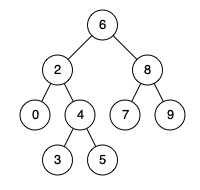| comments | difficulty | edit_url | tags | ||||
|---|---|---|---|---|---|---|---|
true |
中等 |
|
给定一个二叉搜索树, 找到该树中两个指定节点的最近公共祖先。
百度百科中最近公共祖先的定义为:“对于有根树 T 的两个结点 p、q,最近公共祖先表示为一个结点 x,满足 x 是 p、q 的祖先且 x 的深度尽可能大(一个节点也可以是它自己的祖先)。”
例如,给定如下二叉搜索树: root = [6,2,8,0,4,7,9,null,null,3,5]
示例 1:
输入: root = [6,2,8,0,4,7,9,null,null,3,5], p = 2, q = 8 输出: 6 解释: 节点2和节点8的最近公共祖先是6。
示例 2:
输入: root = [6,2,8,0,4,7,9,null,null,3,5], p = 2, q = 4 输出: 2 解释: 节点2和节点4的最近公共祖先是2, 因为根据定义最近公共祖先节点可以为节点本身。
说明:
- 所有节点的值都是唯一的。
- p、q 为不同节点且均存在于给定的二叉搜索树中。
从上到下搜索,找到第一个值位于
既可以用迭代实现,也可以用递归实现。
迭代的时间复杂度为
递归的时间复杂度为
# Definition for a binary tree node.
# class TreeNode:
# def __init__(self, x):
# self.val = x
# self.left = None
# self.right = None
class Solution:
def lowestCommonAncestor(
self, root: 'TreeNode', p: 'TreeNode', q: 'TreeNode'
) -> 'TreeNode':
while 1:
if root.val < min(p.val, q.val):
root = root.right
elif root.val > max(p.val, q.val):
root = root.left
else:
return root/**
* Definition for a binary tree node.
* public class TreeNode {
* int val;
* TreeNode left;
* TreeNode right;
* TreeNode(int x) { val = x; }
* }
*/
class Solution {
public TreeNode lowestCommonAncestor(TreeNode root, TreeNode p, TreeNode q) {
while (true) {
if (root.val < Math.min(p.val, q.val)) {
root = root.right;
} else if (root.val > Math.max(p.val, q.val)) {
root = root.left;
} else {
return root;
}
}
}
}/**
* Definition for a binary tree node.
* struct TreeNode {
* int val;
* TreeNode *left;
* TreeNode *right;
* TreeNode(int x) : val(x), left(NULL), right(NULL) {}
* };
*/
class Solution {
public:
TreeNode* lowestCommonAncestor(TreeNode* root, TreeNode* p, TreeNode* q) {
while (1) {
if (root->val < min(p->val, q->val)) {
root = root->right;
} else if (root->val > max(p->val, q->val)) {
root = root->left;
} else {
return root;
}
}
}
};/**
* Definition for a binary tree node.
* type TreeNode struct {
* Val int
* Left *TreeNode
* Right *TreeNode
* }
*/
func lowestCommonAncestor(root, p, q *TreeNode) *TreeNode {
for {
if root.Val < p.Val && root.Val < q.Val {
root = root.Right
} else if root.Val > p.Val && root.Val > q.Val {
root = root.Left
} else {
return root
}
}
}/**
* Definition for a binary tree node.
* class TreeNode {
* val: number
* left: TreeNode | null
* right: TreeNode | null
* constructor(val?: number, left?: TreeNode | null, right?: TreeNode | null) {
* this.val = (val===undefined ? 0 : val)
* this.left = (left===undefined ? null : left)
* this.right = (right===undefined ? null : right)
* }
* }
*/
function lowestCommonAncestor(
root: TreeNode | null,
p: TreeNode | null,
q: TreeNode | null,
): TreeNode | null {
while (root) {
if (root.val > p.val && root.val > q.val) {
root = root.left;
} else if (root.val < p.val && root.val < q.val) {
root = root.right;
} else {
return root;
}
}
}# Definition for a binary tree node.
# class TreeNode:
# def __init__(self, x):
# self.val = x
# self.left = None
# self.right = None
class Solution:
def lowestCommonAncestor(
self, root: 'TreeNode', p: 'TreeNode', q: 'TreeNode'
) -> 'TreeNode':
if root.val < min(p.val, q.val):
return self.lowestCommonAncestor(root.right, p, q)
if root.val > max(p.val, q.val):
return self.lowestCommonAncestor(root.left, p, q)
return root/**
* Definition for a binary tree node.
* public class TreeNode {
* int val;
* TreeNode left;
* TreeNode right;
* TreeNode(int x) { val = x; }
* }
*/
class Solution {
public TreeNode lowestCommonAncestor(TreeNode root, TreeNode p, TreeNode q) {
if (root.val < Math.min(p.val, q.val)) {
return lowestCommonAncestor(root.right, p, q);
}
if (root.val > Math.max(p.val, q.val)) {
return lowestCommonAncestor(root.left, p, q);
}
return root;
}
}/**
* Definition for a binary tree node.
* struct TreeNode {
* int val;
* TreeNode *left;
* TreeNode *right;
* TreeNode(int x) : val(x), left(NULL), right(NULL) {}
* };
*/
class Solution {
public:
TreeNode* lowestCommonAncestor(TreeNode* root, TreeNode* p, TreeNode* q) {
if (root->val < min(p->val, q->val)) {
return lowestCommonAncestor(root->right, p, q);
}
if (root->val > max(p->val, q->val)) {
return lowestCommonAncestor(root->left, p, q);
}
return root;
}
};/**
* Definition for a binary tree node.
* type TreeNode struct {
* Val int
* Left *TreeNode
* Right *TreeNode
* }
*/
func lowestCommonAncestor(root, p, q *TreeNode) *TreeNode {
if root.Val < p.Val && root.Val < q.Val {
return lowestCommonAncestor(root.Right, p, q)
}
if root.Val > p.Val && root.Val > q.Val {
return lowestCommonAncestor(root.Left, p, q)
}
return root
}/**
* Definition for a binary tree node.
* class TreeNode {
* val: number
* left: TreeNode | null
* right: TreeNode | null
* constructor(val?: number, left?: TreeNode | null, right?: TreeNode | null) {
* this.val = (val===undefined ? 0 : val)
* this.left = (left===undefined ? null : left)
* this.right = (right===undefined ? null : right)
* }
* }
*/
function lowestCommonAncestor(
root: TreeNode | null,
p: TreeNode | null,
q: TreeNode | null,
): TreeNode | null {
if (root.val > p.val && root.val > q.val) return lowestCommonAncestor(root.left, p, q);
if (root.val < p.val && root.val < q.val) return lowestCommonAncestor(root.right, p, q);
return root;
}